Jeff Grubb's Blog, page 17
May 28, 2022
No Quarter: The Next Gen I
So, I don't know if I really want to go on with this blog's ongoing practice of talking about collectible quarters, but old habits die hard. After the States Series and the National Parks series, the US Mint has launched a new collection of collectible/commemorative quarters. And it was pretty easy to mock pictures of birds and mountains and the mudflap that Wyoming used for its quarter. But this new series is on famous American Women, some of whom have passed on in recent memory. So I think I will walk a tad more respectful this time out.
Originally, this was supposed to be similar to the previous currency series, in that each state would get one woman to brag on, but that was revised because they want to do a sesquicentennial (250 years) set in 2026. So we get four years of famous women for 20 total as opposed to 50 national parks/monuments/seashores/parking lots. The idea that women get about 40% of the attention given to other subjects is such an American Thing.
But as I said, I'm going to walk a little more carefully, in part because a lot of these women are unknown/forgotten/ignored in the standard narratives. Also, I'm going to go out on a limb and say that the majority will be from the twentieth century, as opposed to something from the Civil War era, in part because women have been unknown/forgotten/ignored in a lot of traditional texts. I'd like to to concentrate (and mock) the design a lot more than the subject matter, and to encourage readers to follow the links to learn more in detail of these remarkable women.

But first off, let's talk about the other side of the coin, literally. The side with Washington on it.The face/heads/obverse of the coin has made some major changes, and some minor ones. Big one you'll probably notice - Washington is facing the other direction. Also, the sculpture is from a 1931 dollar, and you can see differences in the artistic approach (George has an even thicker neck, and the rat-tail at the back of his head is more pronounced). Also some of the text has switched sides - The denomination and United States of America are now on the other side, and the year moves back to being on the same side as George. As a result the reverse side does have more text to deal with as it previously had
Anyway, I am not expecting a lot of coins to get a review below C (They have gotten much better at it over the past 20 years), but here are the review levels.
Way Cool =A
Not Bad = B
Just Average (also known as Meh) = C
Kinda Lame = D
So bad you don't want to show your mother = E
Maya Angelou (1928-2014)
 This is a strong lead-in, both from subject and presentation. Maya Angelou is known for her autobiographic works and her poetry, but also for her work in Civil Rights. Now I Know Why The Caged Birds Sing is pretty much a standard text for a generation of English classes, and she was the second poet to read one of her poems at a presidential nomination (the first was Robert Frost, the most recent was Amanda Gorman).
This is a strong lead-in, both from subject and presentation. Maya Angelou is known for her autobiographic works and her poetry, but also for her work in Civil Rights. Now I Know Why The Caged Birds Sing is pretty much a standard text for a generation of English classes, and she was the second poet to read one of her poems at a presidential nomination (the first was Robert Frost, the most recent was Amanda Gorman). Her pose is dynamic and evokes Caged Birds in its presentation. I really like it because, right off the bat, it gives us more than the standard portrait and creates an active presentation for the coin. She is also the first African-American woman on a coin. Buckle up, there are going to be a lot of firsts in this series.
Rating: A
Dr. Sally Ride (1951-2012)
 It is no longer big news to have women in space, but Sally Ride was a big thing back in the 80s - the first (American) woman in space. I know - it took us THAT long to put a woman in space, but hey, equality has always been a process. She is also the first known LGBT person on a US coin (get back to the closet, Buchanan - your family burned all your correspondence, so we're still not sure about your status, shy of a seance).
It is no longer big news to have women in space, but Sally Ride was a big thing back in the 80s - the first (American) woman in space. I know - it took us THAT long to put a woman in space, but hey, equality has always been a process. She is also the first known LGBT person on a US coin (get back to the closet, Buchanan - your family burned all your correspondence, so we're still not sure about your status, shy of a seance). The coin itself is, well, OK. Sitting portrait along one side, big globe in the background, bit of a swirl that evokes orbit and window on the shuttle. Its a pretty nice quarter, but nothing that makes me really engage with it.
Rating: B
Wilma Mankiller (1945-2010)
 No jokes on the name, please.While there's a good chance you know about Maya Angelou and Sally Ride, now we get into more esoteric heroes. And its a pity, because Wilma Mankiller's background is impressive, including both Native American activism in California and Oklahoma, and as a chief of the Cherokee people.
No jokes on the name, please.While there's a good chance you know about Maya Angelou and Sally Ride, now we get into more esoteric heroes. And its a pity, because Wilma Mankiller's background is impressive, including both Native American activism in California and Oklahoma, and as a chief of the Cherokee people. The coins are already settling into a comfortable type - figure on the left-hand side, shown torso up, symbology in the background on the right-hand side (A symbol of the Cherokee nation, all contained by a circle with all the required data. I think we are going to lose her note as Principal Chief and the Cherokee words beneath in the folds of her shawl. It is a very busy coin.
Rating: C
Nina Otero-Warren (1881-1965)
 We are probably going to see a lot of suffragettes, particular for those famous women born before 1900. Maria Adelina Isabel Emilia "Nina" Otero-Warren is the oldest representative of this crop of coins, and her achievements span politics and education. She argued for bilingual education and was the first Latina to run for the US House of Representatives (as a Republican. She lost). She is the first Hispanic-American portrayed on US Coinage.
We are probably going to see a lot of suffragettes, particular for those famous women born before 1900. Maria Adelina Isabel Emilia "Nina" Otero-Warren is the oldest representative of this crop of coins, and her achievements span politics and education. She argued for bilingual education and was the first Latina to run for the US House of Representatives (as a Republican. She lost). She is the first Hispanic-American portrayed on US Coinage.Like Mankiller and Ride, we see the sitting portrait on the left side of the coin. In addition, there is a LOT of text - in addition to the stuff shoved onto this side from the obverse side, we have Votes for Women on this side, which to some folk is STILL a controversial subject. Plus a collection of Yucca flowers to represent her native New Mexico. I think it is going to be a cluttered quarter, much like Mankiller's. One good bit - her head does break the plane of the surrounding circle, making it a bit more dynamic.
Rating: C
Anna May Wong (1905-1961)
 Wong Lui-tsong is the first actress on the group, and a pioneering Asian-American in the film and TV industries. That's good. However, a lot of her roles were very much in the stereotypical vamp/dragon lady that smacks of Orientalism and exoticism, so that's a little less good. Plus the fact that a lot of early work are "lost films" that have not survived into the present day, and her ground-breaking TV show was on the now-extinct Dumont network, and few records exist of it as well. Yet she has been recognized for her work in recent years, as well as her work for the Chinese-American community.
Wong Lui-tsong is the first actress on the group, and a pioneering Asian-American in the film and TV industries. That's good. However, a lot of her roles were very much in the stereotypical vamp/dragon lady that smacks of Orientalism and exoticism, so that's a little less good. Plus the fact that a lot of early work are "lost films" that have not survived into the present day, and her ground-breaking TV show was on the now-extinct Dumont network, and few records exist of it as well. Yet she has been recognized for her work in recent years, as well as her work for the Chinese-American community.The quarter itself is exceptional in that it gets away from the already-trope of the previous three with a closer headshot that plays off the natural beauty of Ms. Wong. This is a very stylish coin that feels like a silent movie poster of the era. I like it.
Rating: A
That's it for the first batch - tune in next year for five more, and keep checking your change!
More later,
May 22, 2022
This Just In: Latest Arrivals
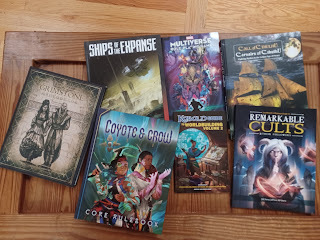 So, more Kickstarters have shown up at Grubb Street, along with the occasional purchase from local brick and mortars and one author copy. As always, I want to note that these are not reviews so much as "first looks", and in most cases I have not read them cover to cover nor tested out their mechanics. But I still want folk to know what's out and what's happening, as opposed to doing a thorough deep dive and getting back to around, let's say ... Christmas.So this is a better approach for me.
So, more Kickstarters have shown up at Grubb Street, along with the occasional purchase from local brick and mortars and one author copy. As always, I want to note that these are not reviews so much as "first looks", and in most cases I have not read them cover to cover nor tested out their mechanics. But I still want folk to know what's out and what's happening, as opposed to doing a thorough deep dive and getting back to around, let's say ... Christmas.So this is a better approach for me.And what do we have in this collection, Johnny?
Grimstone Roleplaying Game (Angelos Krypianos, Writer/Creator Spiral Lane Productions, 126 page Hardback). Greek writers, Greek publisher, this is part of what I was talking about last time in the global nature of RPG design. This is actually the crunchiest of this collection of games, with a great backstory - all of the races are human, but made up of different parts of the Sun and Moon. A nice setting, low-magic, with a unique RPG system.
Ships of the Expanse (Keith Garret, Lem Lemke, Mari Murdock, Nicole Winchester, Writers/Designers, Green Ronin Games, 144 page Hardback). I have not played the Expanse RPG, but I really like the design of the games in this line, and the spaceships in general. It scratches that Traveller itch of my game design history. The Ronins have done a fantastic job with this production, not only on presenting the ships but also talking about hard-science intra-solar system space travel. And I want to unleash these deck plans on others, now. Picked this copy up at Olympic Cards and Comics down in Lacey, which has a LOT of non-traditional RPGs that I don't find elsewhere..
Coyote & Crow (Conor Alexander, Creator/Writer/Developer), Coyote & Crow LLC, 474 Page hardback) There has been a strong movement for authenticity in game design, in particular for games which find their origins in other cultures and heritages. Coyote & Crow, rooted in Native American heritage, is created by mostly Native American talents. The game deals with an alternate cyberpunk North America on a world where the European colonizers were wiped out by a space anomaly before they could get up to any mischief, and the survivors on this side of the planet gained low-level magical abilities. The book is a massive full-size, full-color hardcover. The system itself looks like Shadowrun with d12s, and the worldbuilding itself is interesting. It has also was nominated for a Nebula, which is a rare thing for RPGs (Alas it lost out to Thirsty Sword Lesbians, which was covered in an earlier writeup).
Marvel Multiverse Role-Playing Game Playtest Rulebook (Matt Forbeck, Writer, Marvel Worldwide, Inc, 120 page softbound). Got this at Fantasium, my local comic store as an inexpensive addition to my weekly comics pull, and read through it over the weekend of its release. It is the "playtest copy", but it compares favorably with the now-ancient Yellow Box Marvel. Amused that the ability scores spell out MARVEL instead of FASERIP, and there are diceworks that echo the old D6 system from West End (it has botch dice, which can be negated by .... Karma!). It is what it says on the tin - a playtest copy, so it is not a complete overview of all of Marvel and its powers, and I don't think it has anything for experience and character advancement. Inexpensive and definitely worth checking out (And I welcome Matt into the "Brotherhood of Marvel RPG Game Designers" - next week we fight the Great Lakes Avengers!).
Kobold Guide to Worldbuilding Volume 2 (John Joseph Adams, Editor, Kobold Press, 108 page softbound digest). The Kobold Guides are just fantastic reads - essays by some of the best and brightest in the field on a variety of subjects. The books are veritable wonderland of insights and commentary on various components of campaign, fiction, and world design. An excellent product. Oh, did I mention that I have an essay in this edition? I talk about Space Hamsters.
Corsairs of Cthulhu, Fighting Mythos in the Golden Age of Piracy (Ben Burns, Writer, New Comet Games, 297 page hardback) Pirates Vs. Cthulhu! Who could argue with that? The book consists of a set of modifications to the core Cthulhu rules (the Investigators are now Corsairs, and have skills like Alchemy and Artillery), and a huge world-sweeping adventure. I like some of New Comet's Games (Devil's Swamp was quite good), and don't care for others (A Time for Sacrifice left me cold). Leafing through Corsairs, the adventure itself looks like they have everything and the kitchen sink involved here. Looks very interesting, and may yet get to my gaming table..
Remarkable Cults & Their Followers (JVC Perry, Jeff Lee, RP Davis, Writers, LoreSmyth, 180 page softbound). This is a 21st century version of the Book of Vile Darkness, though its definition of cults extends to factions and secret societies, but has enough that are just Evil Evil Evil. This is a really beautiful book that deals with a great subject for players - Setting up and running cults both as opponents and as player organizations. They have about a dozen cults/secret societies/factions that can be dropped in (including maps of their secret headquarters), along with rules for setting up your own. Plus evil artifacts! It is "system-neutral", which means it plays well with 5E. Of this group, I particularly like the layout and art.
And that's about it for this haul. Did I mention that I have an essay in The Kobold Guide to Worldbuilding, Volume 2? As luck would have it, I talk about Space Hamsters.
More later,
May 8, 2022
Theatre: Mother's Rave

Alma, by Benjamin Benne, Directed by Sophie Franco, Arts West, through May 22.
The Lovely Bride and I took another journey to that mystical land beyond the Duwamish River called West Seattle. I am almost at a point where I can get there without getting lost (the West Seattle Bridge is still shut down). Our goal (in addition to great sushi, is the Arts West Theatre, a small but great theater group ensconced in the shell of a renovated former furniture store. The LB and I have been hitting opening nights, and to a great degree, have be rewarded for the effort.
Case in point, Alma. Yolanda Suarez is Alma, Leah Sainz-Jones is her daughter, Angel. Angel is supposed to be taking her SATs tomorrow. Alma has been preparing for this day, the next step of her daughter's success, to have the life she was denied. Angel does not plan to take the test. The resulting discussion/argument is the core of the play itself. Two actors, one problem, ninety minutes.
And the playwright pulls it off. The analyst in me can tweak to the ratcheting up and unwinding of dialboue as their relationship plays out over the course of the argument. Alma and Angel are friends and also mother and daughter, with all the baggage and hidden traps that that involves. They curse, bluster, accuse, mock, make up, cuddle, cry, tease, and love each other, and the script itself dances from one point to another.
Also a sizable chunk of the dialogue is in Spanish, in that halfway domain in families where the parent has come from another country and the child groks the new language. Yet they slip in and out of it gracefully, and there are only a few points where I felt I missed something - that would be the universal nature of parent/child relationships. Also the PTSD that comes from High School testing.
There's a third player on-stage, unseen but not unheard- America and the American Dream. The ghosts of an old country. The play takes place in that weird temporal borderland between Trump's election and inauguration, in that weird quantum state when everyone was wondering how bad could it be. The newly-elected voice, over a malfunctioning TV, blasts into their lives about building a wall and making Mexico pay for it (yeah, how did THAT work out). Alma is an illegal, and Angel is aware that the rules have changed, and what they have both hoped for is now much, much more difficult.
The set design is excellent, open-spaced and beneath (at times) the stars, setting the eternal nature of the parent/child discussion. The program book also carries a bit of weight in the proceedings. There is interview with the director, which is par for the course, but also a page of translations and explanation of what the Prologue (storms, horses, soldiers, Military music) means within the larger whole. Even th art in the hallway underscores the players on the state. It was very much a total package.
Alma is a small play (Two people and the ghost of the American Dream) and a greater play as well, set within its time and within the long timeline of mothers and daughter. I liked it, and think you would too.
More later,
May 4, 2022
Book: Pulp Fiction
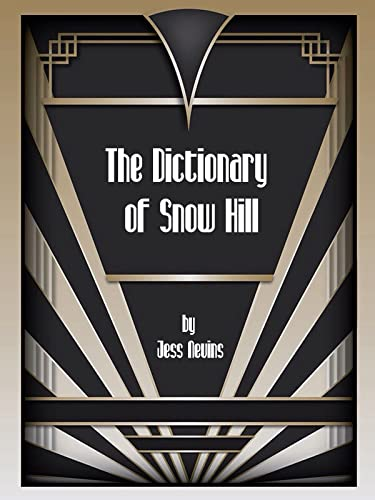 The Dictionary of Snow Hill by Jess Nevins, 2022
The Dictionary of Snow Hill by Jess Nevins, 2022Provenance: Another book recommended by Facebook ads. I get a lot of ads for books on Facebook, so the Algorithm has me pegged. Yeah, I'm getting worried about that as well. This one caught my attention because of the Author - Jess Nevins. Nevins has written one of my favorite reference books (You have a favorite reference book, right?): The Encyclopedia of Fantastic Victoriana, as well as doing annotations on things like Alan Moore's League of Extraordinary Gentlemen comics. So, yeah, he comes from a good background, so I'm in.
Review: This is a love-letter to Pulps of the 20's and 30's, with parts spilling over to before and after that era. Set in the Maryland city of Snow Hill, the largest and shiniest city in the US, it is a collection of tales involving Science Heroes and Villains. This is tropes gone wild, and features a host of familiarish players - Micheal Ferrum, the two-fisted "Doc Bronze" and his Sensational Six, World-famous Consulting Detective Havelock Blake, the Shadow-esque Laughing Monk, along with talking ape detectives and luchadors. Roman a clef with the predecessors of the super hero universes.
Yes, it is a madhouse, literally so in places. There are invasions from other planets, inner worlds, and undersea menaces. Lovecraftian horrors abound (and we have the Doctor Strangish/Inner Sanctum magician named Anton Weird in the mix as well). It is a world where all the heroes of the pulps are all active at the same time, sharing the same universe and the some of the same enemies. Physics itself tends to bend around such challenges.
The format is in encyclopedia format with rough alphabetization. Entries are narrated by different in-world inhabitants, so we have unreliable narrators throughout. Radio scripts, media articles, and personal memories all mix and twist. Being an overview of the various characters' careers, many of them end badly. Particularly there is a lot of reference to the events of June 21st, 1937, a solstice where many things go badly for many, many people. This is the ongoing narrative that stretches throughout the book, the approaching cliff that the characters are hurtling towards.
So, does Nevins gather together the collected strands and resolve them? He has been an annotator of a lot of Alan Moore's work, and Moore has had challenges with stories not so much resolving as running out of pages, and of playing nastily with his creations. Does Nevins "stick the landing"? Yes, in part because of the unreliable nature of his narrators and the who is giving information when in the book. There are a couple tweaks and twists, but the book delivers.
The Dictionary of Snow Hill entertains and delights. It would make a solid sourcebook for a era-specific superhero gaming campaign. It feels very much like Kurt Busiek's Astro City comics - Set firmly within its genre, with characters whose archetypes are easily identified. It's a great read if you remember the pulps, and worth checking out even you don't.
More later,
May 1, 2022
Theatre: Tuned to a Dead Channel
 Selling Kabul by Sylvia Khoury, Directed by Valerie Curtis-Newton, Seattle Rep through 22 May
Selling Kabul by Sylvia Khoury, Directed by Valerie Curtis-Newton, Seattle Rep through 22 MayThis one is rough. It is a challenge. It was also the best production of the year so far.
Part of the challenge is subject matter - a play about Afghanistan so soon after the recent departure of US military support, the collapse of its government, and return of the Taliban. And part of it because of the characters themselves, all of whom are confronted with the ever-increasing danger resulting from the lies they tell to protect each other. You empathise with them and and internalize their peril.
Taroon (Yousof Sultani) has been hiding in the apartment of his sister Afiya (Susaan Jamshidi) and her husband Jawid (Barzin Akhavan) for four months now. Taroon worked for the Americans and is hiding from the rising Taliban. Jawid is making uniforms for the Taliban in exchange for their protection. Afiya is trying to hold everything together, including keeping Taroon's presence hidden from the outside world, which is embodied by friendly/nosy neighbor Leyla (Fatima Wardak). At the start of the play, Taroon's wife has given birth to their son in the hospital, and Taroon is willing to risk everything to see them. However, the Taliban has people at the hospital looking for him. Afiya want to keep her brother alive.
And from there is just gets worse for everyone involved. It is a slow burn as the truth regarding the devastation from the authoritarians is revealed, and as the knowledge of the danger to the major characters is slowly leaked out. The risks ratchet up, the potential dangers increase, and the collateral damage is high.
The actors are excellent. Most of them are "making their Seattle Rep debut" with the exception of Wardak, who had been in A Thousand Splendid Suns from the Rep a few years ago (and which is being apparently being turned into an opera). They embody their characters and their secrets with grace and humanity. Jamshidi as Afiya is the heart of the play, as she struggles to work out the most survivable results in an ever-darkening landscape. The set is no-nonsense, will none of the flying props or multiple levels we've seen in other Rep productions. And the directing is subtle, direct and well-placed. As I said, it is a slow burn.
This is a bleak play. Much bleaker than Ghosts, and much, much more immediate. There are fewer laughs at these characters, less distance between us and them. The performance is gifted with excellent actors, a tight script, and spot-on direction. I really, really don't want to take it apart and analyze why it works right now because it really connected and affected me. So yeah, with all the caveats that this is not a musical, not a blast from the past, not a retelling of another better known play, but is really solid, good theater. Just don't expect to feel good about it afterwards.
More later,
Theatre: Darkness Falling
 Selling Kabul by Sylvia Khoury, Directed by Valerie Curtis-Newton, Seattle Rep through 22 May
Selling Kabul by Sylvia Khoury, Directed by Valerie Curtis-Newton, Seattle Rep through 22 MayThis one is rough. It is a challenge. It was also the best production of the year so far.
Part of the challenge is subject matter - a play about Afghanistan so soon after the recent departure of US military support, the collapse of its government, and return of the Taliban. And part of it because of the characters themselves, all of whom are confronted with the ever-increasing danger resulting from the lies they tell to protect each other. You empathise with them and and internalize their peril.
Taroon (Yousof Sultani) has been hiding in the apartment of his sister Afiya (Susaan Jamshidi) and her husband Jawid (Barzin Akhavan) for four months now. Taroon worked for the Americans and is hiding from the rising Taliban. Jawid is making uniforms for the Taliban in exchange for their protection. Afiya is trying to hold everything together, including keeping Taroon's presence hidden from the outside world, which is embodied by friendly/nosy neighbor Leyla (Fatima Wardak). At the start of the play, Taroon's wife has given birth to their son in the hospital, and Taroon is willing to risk everything to see them. However, the Taliban has people at the hospital looking for him. Afiya want to keep her brother alive.
And from there is just gets worse for everyone involved. It is a slow burn as the truth regarding the devastation from the authoritarians is revealed, and as the knowledge of the danger to the major characters is slowly leaked out. The risks ratchet up, the potential dangers increase, and the collateral damage is high.
The actors are excellent. Most of them are "making their Seattle Rep debut" with the exception of Wardak, who had been in A Thousand Splendid Suns from the Rep a few years ago (and which is being apparently being turned into an opera). They embody their characters and their secrets with grace and humanity. Jamshidi as Afiya is the heart of the play, as she struggles to work out the most survivable results in an ever-darkening landscape. The set is no-nonsense, will none of the flying props or multiple levels we've seen in other Rep productions. And the directing is subtle, direct and well-placed. As I said, it is a slow burn.
This is a bleak play. Much bleaker than Ghosts, and much, much more immediate. There are fewer laughs at these characters, less distance between us and them. The performance is gifted with excellent actors, a tight script, and spot-on direction. I really, really don't want to take it apart and analyze why it works right now because it really connected and affected me. So yeah, with all the caveats that this is not a musical, not a blast from the past, not a retelling of another better known play, but is really solid, good theater. Just don't expect to feel good about it afterwards.
More later,
April 22, 2022
The Reading
So, how did it go?
All in all, it went very well. Very well indeed.
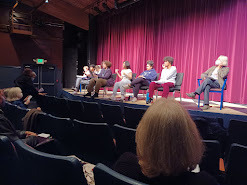 Readers at the TheaterThis past Monday, our play-writing group, The Quills, held a reading of our works at the Driftwood Players in Edmonds. The Quills are a group of would-be playwrights who have been meeting mostly monthly for the past few years, reading scenes and commenting on each others work. This was the first public reading of most of them.
Readers at the TheaterThis past Monday, our play-writing group, The Quills, held a reading of our works at the Driftwood Players in Edmonds. The Quills are a group of would-be playwrights who have been meeting mostly monthly for the past few years, reading scenes and commenting on each others work. This was the first public reading of most of them.This was reader's theater, which meant we were not doing blocking, sets, action, or anything. Just sitting in chairs. The Readers, a group of students from Shorecrest High School and some women of a certain age who were friends of the other playwrights were seated in front of the curtain. OK, I read for one of the plays, which needed an older man of a certain age for the reading.
The plays were a a mixed bag of types we've been working on, and included: Plays about earthquakes, WWII history, masking, layoffs, moving to Seattle, sending kids to college, making a recipe book in a concentration camp, and wildfires. And lest you guess, I was responsible for the layoff and wildfire scenes. They were comedies.
The venue was excellent, with great sound (though we had to get the young people to speak up initially), and they even managed to put the music from the Moving to Seattle play over the speaker system. It is a large small theater with a lot of seating. Edmonds is more than an hour north of Grubb Street, but I'd definitely take in a play there again.
And the readers were good. There were a couple misfires - one young person referred to a local restaurant as "Ivan's" instead of "Ivar's - but in general they acquitted themselves well. There were a couple of the younger folk who understood the brief and took control of their parts. That qwas greatly appreciated.
We had, counting authors, actors, and audience, about 50-60 people total in the house. The overwhelming bulk were friends and family of the playwrights. We passed out review sheets and encouraged people to respond to the plays. Most of the friends and family were very kind their comments. Since my plays were comedies, I was hunched in my seat, seeing what lines landed and which ones missed. Most of them landed.
The Housemates made the long drive up to Edmonds, as did a couple who were members of my regular Monday Night D&D group and a fellow designer from Amazon. Afterwards a group of us adjourned to Bucatini, a small Italian joint about four minutes south of the theater. The food was excellent, the portions large, and the conversation involved a lot of gossip about Amazon.
Thanks to fellow Quills Catherine Benson, who organized the whole shebang, Susan Weingarten, who MCed the proceedings, and Lisa Emerson who provided the response sheets. And of the young readers, a shout out to Peyton Catt, who will never know I've given him proper credit unless he's the kind of person who googles his own name.
And who knows? We may do it again sometime.
More later,
April 16, 2022
Invitation to a Reading
You are cordially invited to:
The Quills New Works Evening
Monday, April 18th, 2022
6 PM to 8 PM
Edmonds Driftwood Players
(Wade James Theater)
950 Main St. Edmonds, WA
The Quills are a group of amateur playwrights from the Seattle area. Please join us for the first public reading of our short works and scenes from longer plays.
Free (But we will be soliciting feedback)
Masks are required for the audience.
So what's all this?
Many (many) years back, I took a couple play-writing classes at the Seattle Rep, taught by Kristina Sutherland. After those classes, a group of us would-be playwrights stayed together, and have met once a month to share scenes and talk about play-writing. This is the first time a lot of these scenes are going to be seen in a readers' theater atmosphere (Readers up on the stage but in front of the curtain, no blocking or sets, but real voices reading our stuff).
While I would not recommend flying in for the event (and even a drive from Tacoma might be a bit much), if you happen to be in the North Seattle area and have a free evening this Monday, come check us out!
More later,
April 15, 2022
Theatre: Norwegian Would
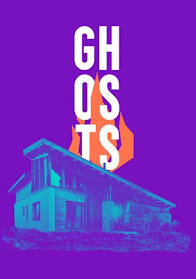
Ghosts by Henrik Ibsen, Translated from the Norwegian by Paul Walsh, Directed by Carey Perloff, Seattle REP through May 1
On the drive home from this play, the Lovely Bride wondered if it was time to retire Ibsen from the theatrical canon.
This is a major statement on her part. Ibsen had a strong impression on her in her youth. The LB had an Ibsen phase growing up (She also had a Bertolt Bretcht phase, but we won't dwell on that here). Ibsen wrote strong women into his works and castigated moral hypocrisy and talked about issues that were at that time conveniently buried beneath the floorboards. If modern theatre had a list of saints, Ibsen would at the head of the line. So, retire him from performance? Seriously?
Let me get to that matter in a moment - I need to walk through the play itself. Helena Alving, widow of ten years, lives on a manor out in the wilds of Denmark. She is on the verge of dedicating an orphanage on her grounds to her late husband. Her son has returned from Paris. She has a dedicated maid, whose ne'er-do-well father is overseeing the orphanage's construction. She is dealing with the final details with the family pastor, who is an old and affectionate friend. Things are going well.
Well, no. Secrets start leaking out. Helena's sainted husband was a philandering bastard. The dedicated maid is really the husband's illegitimate child. The son is taking a shine to the maid, risking inadvertent incest. And the son, back from Paris, has venereal disease, which in the Ibsenian universe is inherited from the father and also results in sudden and certain madness. And the orphanage is uninsured, for, in the words of the Pastor, to insure it would be to show a lack of faith in god to protect it. So you know where that is going.
And yeah, that line about insurance got a laugh in the audience. In fact, a lot of Pastor Mander's lines got inadvertent laughs, which I am going to say was not the intent back in the 1880s. Mander's hypocrisy and stiff-necked morality is met with derision by modern audiences, so the lines land completely differently now than they did then. For a harbinger of modern theater, Ibsen comes off as, well, quaint.
The cast is crackerjack. Award-winner David Stratharin as Pastor Manders is soft bullying, responding to society's requirements as his compass. But Mary Elizabeth Mastrantonio is the heart of the play, dominating the stage and by turns conventional and rebellious, the look on her face when the Pastor's plans come crashing down on his ears is electrifying. Albert Buio III and Thom Sesma are good in their roles as the scion of the Alvings and the carpenter, respectively, but it is Nikita Tewani as Regina, the maid, that ultimately shines as she denies Helena her happy ending, and for excellent reasons.
The roles throughout are played subtlety as well. Sesma's carpenter could be more snakelike, Straitharn's Pastor even more stiff-necked, but the direction gives them nuance and depth that could otherwise be lacking. The actors are portraying their characters more realistically, to a degree that I don't know would have been possible on the 19th century stage.
The set design is intriguing as well. The manor's setting with its grass roof makes it feel like a barrow grave, its pale wood timbers definitely fit for IKEA. And in the center back is a glass-paneled room that serves both as storage for lost furnishings and as housing for David Coulter, who provides the music. Coulter's work does a lot of the heavy lifting for the tone of the work, creating musical effects on tympani, zither, and glass armonica (I'm guessing here) that underscore the unsettled nature of the characters.
The pieces are all here, but it still feels odd. And the fault is not in the original work or the actors, but rather in the fact that it belongs to a different time and a different audience. The 21st Century has moved through the shock value of forbidden topics (though we will always still find them) and what required stern reflection is now met with nervous laughter. What was once scathing is now just cringe. The past, indeed, is another country, and in the case of Ghosts, it is a desolate county indeed.
More later,
April 10, 2022
Life in the Times of the Virus: Mandate's End
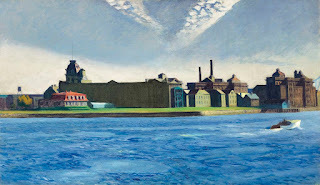 Blackwell's Island - Hopper, 1928
Blackwell's Island - Hopper, 1928The numbers have come down, and with it the barriers are slowly falling. Mask mandates and working from home decisions are falling, one by one. There are no church bells ringing - this is not a war declared won. It is merely a war declared over. A draw, if we are lucky. A resurgence if we are not.
And the reasons for declaring this cease-fire are good enough, but not great. We don't have maximum vaccination, but we have enough in our region to staunch the outbreaks. Those who are vaccinated seem to be having milder symptoms, but are still getting "Breakthrough" Covid. The stories have shifted from "Public anti-vaxer who then dies horribly" to "Famous person, vaccinated, who tests positive and secludes for about a week". A lot of those reports, ironically enough, have declared Coivd is like having the flu, something the nutjobs were claiming at the beginning of all this. It might be the worst flu of your life, but still .... the flu. And yeah, the flu can kill people.
But we are no longer overloading ERs and storing bodies in refrigerator trucks or buried in mass graves. We still have people super-spreading (most recent, someone attending GDC, a big game developers' conference, after they tested as positive with the disease). We still have people catching it and yeah, dying from it. But the numbers are almost in the manageable state, and we really, really want to forget about it.
So the mask mandates are elapsing and not being renewed. Compliance varies from situation to situation. My grocery store is about 50-50 right now. My friendly comic shop has dropped mask requirements and resumed evening gaming events. Theaters are definitely still requiring masks for the audiences. My favorite rib joint has done away with them entirely. On the other hand, the airline industry is completely fouled up because it doesn't have enough staff in the face of folk calling in sick.
Me? I'm still comfortable with masks, so I keep using them for the moment. If the workers where I go shopping are masked, I'm going to help out by wearing a mask. If not, I'm still going to go with masking becuase they are not horribly uncomfortable (speaking as someone who spent many winters in Wisconsin, and used to something called scarfs). I have a mask in my jacket pocket. And a spare mask in my zippered jacket pocket. And one in the car. And a door mask. And a desk mask, still in its original plastic bag. Just to be sure.
As I write this, the numbers are slowly bumping back up again. They are talking about a new variant. Omicron XE, which sounds like it was named by Microsoft's marketing department. There are articles on long-term effects of Covid. And the Feds have approved a second booster for us late-middle-aged folks. It does not feel like it is truly over, but I really, really want to be done with it this time.
But if it is not, well, we know what we have to do.
Jeff Grubb's Blog
- Jeff Grubb's profile
- 191 followers



